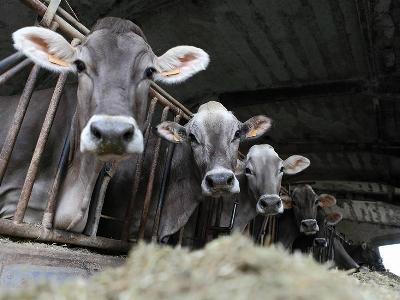Preventing common metabolic disorders in dairy cattle
Nutrition goes a long way in combating post-calving complications.The transition period is probably one of the most critical times in the dairy cow's production
 5 tips to keep cattle healthy during winter
5 tips to keep cattle healthy during winter Feeding adjustments can help your cattle weather the cold. As winter approaches in the Northern Hemisphere, there are measures beef and dairy cattle producers
 Cow Health: Heat stress
Cow Health: Heat stress Heat stress occurs when a dairy cow's heat load is greater than her capacity to lose heat, and is sometimes referred to as hyperthermia.
 Cow Health: Theileriosis
Cow Health: Theileriosis Theileriosis is a disease caused by a species of Theileria a blood-borne parasite that only affects cattle and is primarily transmitted by ticks.
 Cow Health: Johne's Disease in cow
Cow Health: Johne's Disease in cow Johne's Disease is a chronic, contagious and sometimes fatal infection caused by Mycobacterium avium subspecies paratuberculosis (MAP). It is an immune reaction
 Cow Health: Milk fever in cows
Cow Health: Milk fever in cows Milk fever is a metabolic disorder caused by insufficient calcium. Magnesium plays an important role in milk fever prevention (calcium deficiency).
 Cow Health: Ketosis in the cow
Cow Health: Ketosis in the cow Ketosis is a metabolic disease that occurs when the cow is in severe state of negative energy balance.
 Cow Health: Cow Lameness
Cow Health: Cow Lameness Lameness is caused by many factors which differ between individual cows and farms. Reducing the number of lame cows on your farm therefore requires a long-term
 Cow Health: Sodium deficiency
Cow Health: Sodium deficiency Sodium is an essential element for animals. Dairy cows routinely expel Na from the body in urine, faeces, saliva and milk which has to be replaced.
 Cow Health: Copper deficiency
Cow Health: Copper deficiency Copper (Cu) deficiency in cattle is a common and complex problem. Dairy cows are most likely to be deficient in winter/early spring, coinciding with higher
 Cow Health: Diarrhoea in Calves (Scours)
Cow Health: Diarrhoea in Calves (Scours) Calf scours is a broad, descriptive term referring to diarrhoea in calves. Calf scours is not a specific disease but the clinical sign of a disease complex with
 Cow Health: Grass staggers
Cow Health: Grass staggers Grass staggers (tetany) is a metabolic disease caused by magnesium deficiency and is also called hypomagnesaemia. The cow is dependant of what Magnesium
 Cow Health: Facial Eczema (FE)
Cow Health: Facial Eczema (FE) Facial Eczema (FE) is a disease which causes lowered production, skin irritation and peeling and sometimes death
 Cow Health: Bovine viral diarrhoea virus
Cow Health: Bovine viral diarrhoea virus Bovine viral diarrhoea virus (BVD) may affect up to 60% dairy cows and 90% herds. BVD limits production, causes reproductive losses and may lead to death
 Keep Your Horses Hydrated and Their Waterer Clean
Keep Your Horses Hydrated and Their Waterer Clean This summer was a hot one and your horses likely felt it. No doubt, you stayed on top of hydrating your horse’s supply of water and making sure they were well
 Keeping Your Stalls Clean and Your Horses Healthy
Keeping Your Stalls Clean and Your Horses Healthy It’s finally fall and a perfect time to step up your cleaning regimen in the stable. We’ve targeted 3 key areas to minimize health risks for your horses, stable
 Horse Health: Hydrating Your Horse after Running or Racing
Horse Health: Hydrating Your Horse after Running or Racing It is important to properly cool down your horse after a hard workout such as jumping or racing. Like all athletes, horses need to cool down to avoid getting...
 Are Your Livestock Drinking Enough Water?
Are Your Livestock Drinking Enough Water? Water is essential to the life of all livestock and is important to continually replenish. Water aids in the digestion of feed, milk production, performance.
 Raising Livestock: Keeping your livestock cool this summer
Raising Livestock: Keeping your livestock cool this summer For stock that can be haltered, pamper them. Baths can be so cooling, however, that you have to be careful not to send your animals into temperature shock.
 Raising Livestock: How to Raise Premium Livestock for Making Money
Raising Livestock: How to Raise Premium Livestock for Making Money You may remember the old Wendy’s ad: “Where’s the beef?” If you’re considering raising livestock for a living, you need to do your research, make a commitment
